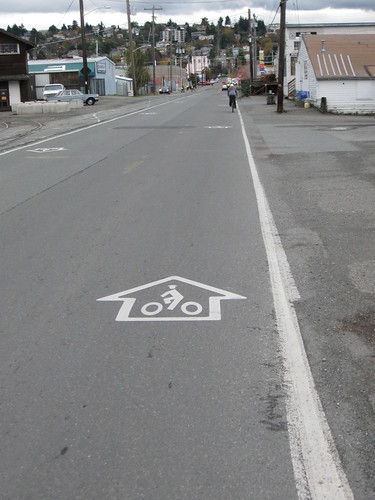
NOPA will get more Shared Lane Markings on its streets in the next several weeks as part of the Municipal Transportation Agency's effort to make bicycling safer in the city. Twelve of the markings, also known as "sharrows," will appear on Hayes Street from Baker to Scott while another eight will be painted on Baker Street from Fell to Page. (Nearby Parker Street west of Masonic between Golden Gate and Turk Streets will also get a pair of the markings). Sharrows aren't completely new to NOPA. In fact, Hayes Street between Baker and Divisadero already sports sets of the markings.
The sharrows are part of the city's bike plan that the Superior Court recently allowed with a partial lifting of the injunction that has stymied bike improvements for more than three years. The city currently has 23 miles of sharrows but expects to increase that number by 326% in the next six months, according to a December 3rd report in Streetsblog, usually four to a block, two on either side of two-way streets.
The markings have a big job to do, if they provide the safety benefits that traffic engineers intend:
- direct cyclists away from the dangerous "door zone"
- discourage wrong way bicycling on a busy street
- discourage bicycling on sidewalks which cyclists sometimes do when the street is especially unfriendly and risky
- discourage motorists from squeezing cyclists against curbs or parked cars
The MTA notes in a recent presentation that these shared markings have been found to improve bicycling safety in all the ways listed above, but they are not meant to be substitutes for dedicated bike lanes.
A word about that name, "sharrows": until you know, it doesn't make much sense. The easiest explanation is to think of "shared use" and "arrows." The chevron marking, double arrows, and the accompanying bicycle icon indicate that bicyclists should generally stay within the sharrows area to avoid getting doored or getting squeezed by passing vehicles. And motorists should really share the roadway. SFMTA's Program Manager Oliver Gajda gets the credit for coining the term "sharrows."
Bicyclists debate the usefulness of the sharrows. Some question whether the markings give a false sense of security when drivers often ignore the markings or see them as a reason to speed up and try to pass a cyclist with little regard for the hazards they create. Others cite their own experiences or studies that suggest the markings do help. Most recognize that beginning bicyclists appreciate the sharrows to guide their route and to alert drivers to their presence.
Sharrows come at a good price: about $150-200 per marking. They also last a reasonably long time: from two to five years, depending on vehicle use of the marked street.
Sharrows are a San Francisco creation! In 1998 San Francisco refined an early version of a bike icon within an "arrow house" (see the drawing for this to make sense) developed in Denver.

Photo by Michael Snyder on Flickr
San Francisco officials created the current design (below), studied its impact, and then obtained approval from the state to include sharrows in the official Manual of Uniform Traffic Control Devices or MUTCD. (We extend our sympathy to traffic engineers who have to use, or pronounce, acronyms like this). Now cities all over the country -- even Portland -- have adopted sharrows in their bicycle programs. So NOPA: share the lane, enjoy the sharrows.

For the full report "Shared Lane Markings: Where and When to Use Them," by Mike Sallaberry, see this pdf doc on the SFMTA site.
No comments:
Post a Comment